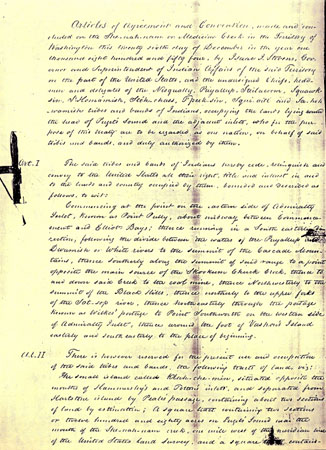Original Treaty of Medicine Creek, 1854, To Go on Display
The Treaty of Medicine Creek, 1854, will be the sixth original treaty go on display at the National Museum of the American Indian in the exhibition “Nation to Nation: Treaties Between the United States and American Indian Nations.” The Treaty of Medicine Creek secured the fishing rights of nine Native tribes and bands along Puget Sound in Washington state, including the Nisqually, Puyallup and Squaxin Island tribes, in exchange for 2.5 million acres ceded to the United States. The original document, on loan from the National Archives and Records Administration (National Archives), will be installed March 23 and will remain on display through August 2017.
The key provision affirming the tribes’ right to fish “at all usual and accustomed grounds and stations,” found in Article 3 of the treaty, is echoed in four other treaties with Washington tribes: Neah Bay, Olympia, Point Elliot and Point No Point. Similar language is also found in treaties between the United States and tribes in the Columbia River and Great Lakes regions.
As more settlers migrated west, tribal access to fish became more restricted. The tension eventually led to the Fish Wars of the 1960s, protests in which tribes sought to have their treaty fishing rights recognized. In the case U.S. v. Washington (1974), Judge George H. Boldt ruled that the treaties guaranteed the Washington tribes’ right to harvest 50 percent of the fish passing through their usual and accustomed fishing places. After their treaty rights had been ignored or denied for decades, the tribes could exercise their sovereign right to fish where their ancestors had, long before the existence of Washington state or the American republic.
Displaying original treaties in rotation in “Nation to Nation” is made possible by the National Archives, which is a partner in the exhibition. Several of the treaties required major conservation treatment by the National Archives’ conservator prior to loan. Past treaties on display include:
- Treaty of Canandaigua between the Haudenosaunee and the United States, 1794
- Treaty of New York between the Muscogee Nations and the United States, 1790
- Horse Creek Treaty (The Great Smoke; Fort Laramie Treaty; Treaty of Long Meadows) among the Arapaho, Arikara, Assiniboine, Cheyenne, Crow, Hidatsa, Mandan and Sioux Nations and with the United States, 1851
- Treaty between the Potawatomi Nations and the United States, 1836
The treaty currently on display is Treaty K, between the Native Nations in California and the United States, 1852 (Treaty at Temecula between the Luiseño, Cahuilla and Other Nations and the United States, ratified Jan. 5, Treaty Commissioner O.M. Wozencraft, unratified [Senate vote not to advise and consent], June 28). There are a total of over 370 ratified Indian treaties in the National Archives. For more information about these treaties, see https://www.archives.gov/research/native-americans/treaties.
About the Exhibition
Treaties lie at the heart of the relationship between Indian Nations and the United States. “Nation to Nation: Treaties Between the United States and American Indian Nations” is the story of that relationship, including the history and legacy of U.S.–American Indian diplomacy from the colonial period through the present.
About the National Museum of the American Indian
For additional information about the National Museum of the American Indian, visit AmericanIndian.si.edu. Follow the museum via social media on Facebook, Twitter and Instagram, and take part in the treaty discussion using the hashtag #HonorTheTreaties.
About the National Archives and Records Administration
The National Archives and Records Administration ensures, for the citizen and the public servant, for the President and the Congress and the Courts, ready access to essential evidence that documents the rights of American citizens, the actions of federal officials and the national experience from the nation’s beginnings in 1774.
# # #
SI-125-2016
Bethany Bentley
202-633-8293

